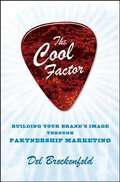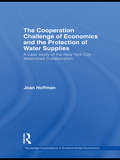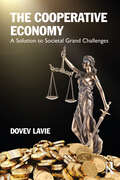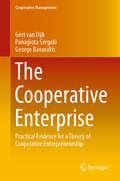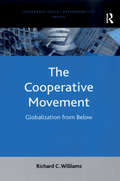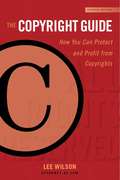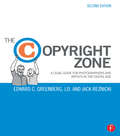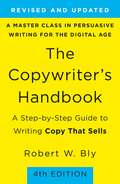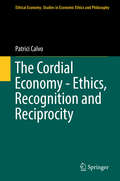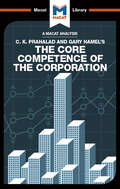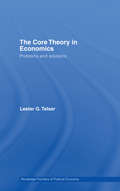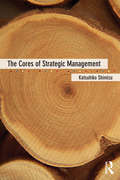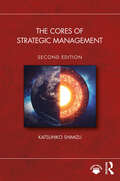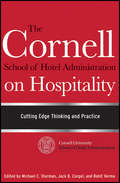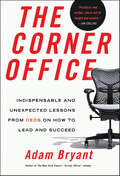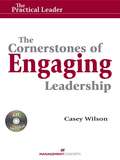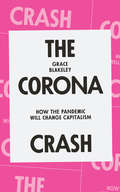- Table View
- List View
The Conversion Code: Stop Chasing Leads and Start Attracting Clients
by Chris SmithThe new edition of the bestselling book for real estate agents, loan officers, SaaS and small businesses. In this revision, The Conversion Code: A Step-by-Step Guide to Marketing and Sales that Will Grow Your Business Faster, Second Edition, digital marketing and lead conversion expert Chris Smith delivers the ultimate exploration of the marketing and advertising tactics that are successfully generating higher quality leads that are easier for salespeople to convert. Smith researches and tests the latest and most popular platforms, including TikTok, YouTube and Instagram, while also studying the most effective sales techniques, tools, and scripts. In this book, you'll learn to: Increase your lead conversion rate, reduce your cost per lead and improve your overall ROI from marketing and sales Generate an endless supply of high-quality leads from social media that are easy to convert into closed sales Stop chasing leads and start attracting clients with amazing marketing and clever ads Adapt to the consumer privacy changes that have made targeting ads and getting leads to answer the phone harder than ever Differentiate your brand in a way that positions you as the authority and gets people contacting you who are already sold An invaluable reference and easy to follow guide for real estate agents, loan officers, SaaS and small businessescompeting in the hyper-competitive online environment. The Conversion Code, Second Edition, is also a fantastic resource for sales leaders, marketing managers, business owners and anyone else with a team who is responsible for growing revenue.
The Cool Factor
by Del BreckenfeldWhat is cool? Who knows. But there is one thing every marketer does know- nothing increases sales like cool does. In The Cool Factor, Del Breckenfeld, a long-time marketer at Fender® Musical Instruments Corp., presents an inside look at how Fender became the coolest name in musical instruments and how marketers at Fender partnered with cool products, musicians, and events to up their "cool factor" even more. If you're a marketer, The Cool Factor offers lessons for keeping your brand on top.
The Cooperation Challenge of Economics and the Protection of Water Supplies: A Case Study of the New York City Watershed Collaboration (Routledge Explorations In Environmental Economics Ser.)
by Joan HoffmanHow can we build the institutions that will promote the cooperation needed to meet our intertwined environmental and economic needs? Efforts to meet these twin goals in New York City’s watershed collaborations offer some guidance. The experience provides lessons in addressing scattered sources of pollution, encouraging environmentally compatible economic development, and coping with conflicts that are part of the collaboration process. It also yields insights into what we need to work effectively towards sustainable economic development. This book identifies many barriers to achieving the cooperation necessary to solving our water problems and discusses how watershed collaborations are a means to overcoming those barriers. Historical experience and lessons from other watershed collaborations informed the design of New York City’s complex watershed collaboration which is shown to contain the elements of a "green milieu" that can foster sustainable economic development. The particular challenges to the collaboration’s environmental and economic goals created by the watershed’s rural economy, farming and forestry are described. The unusual inclusion of the analysis of the economic aspects and effects of collaboration, of the relationship between collaboration and sustainable development, and of the processes of implementation and conflict make this book especially valuable to those interested in collaboration, regulation, environmental cooperation and conflict, watershed protection, economic development in general, and sustainable economic development in particular.
The Cooperative Economy: A Solution to Societal Grand Challenges
by Dovev LavieSocietal grand challenges have taken a toll on humanity, which finds itself at a crossroads. The concentration of wealth and economic inequality, the dominance of Big Tech firms, the loss of privacy and free choice, and the overconsumption and abuse of natural resources have been reinforced by globalization. Regulation, legislation, international treaties, and government and corporate policies have fallen short of offering sufficient remedies. This book identifies the root cause of these problems and offers a bold solution: a new economic system, free from the design flaws that have contributed to these societal grand challenges. The proposed cooperative economy is an ethical community-driven exchange system that relies on collective action to promote societal values while accounting for resource constraints. Unlike the modern economic system that is predominantly driven by opportunistic behavior, the cooperative economy moves away from a materialistic orientation and follows a more balanced perspective that leverages prosocial behavior. The book explains how this new system adopts design principles that promote self-sufficiency of communities, sustainability and entrepreneurship while limiting overconsumption and excessive profit-making. It enhances economic equality by leveraging price subsidization and by restricting salary differences. The book describes how the system serves the interests of consumers, vendors, and employees while preventing the accumulation of power by the platform owner who operates this system. This book is invaluable reading for policymakers who have been searching for solutions to some of the grand challenges that our society faces, and to managers who have sought alternative ways to cope with platform ecosystems, resource shortages, and supply chain disruptions. It revisits long-held assumptions, offering a treatise and food for thought, as well as a plan for concrete action. The book is also highly relevant to scholars and students in the study of economics, strategy, innovation, and public policy and to all readers who are concerned about the future of our planet and society.
The Cooperative Enterprise: Practical Evidence for a Theory of Cooperative Entrepreneurship (Cooperative Management)
by George Baourakis Gert van Dijk Panagiota SergakiThis book presents a study of cooperatives as a two-layer entrepreneurial model, and analyzes cooperative enterprises. Above all, it explores how inducements (from the firm) and contributions (from its members, in their respective roles) are aligned, and seeks to answer the question of what this means for managing each cooperative as a firm as well as a group. The book is divided into three parts, the first of which begins with an analysis of specific aspects of cooperative enterprises, with a focus on the added value of cooperation, the weighing of interests, and a behavioral perspective on the imminent communities and their goals. In a structured approach, the book examines the various facets of relationships in cooperatives on a transactional, financial and control level. Further, a case study on the Dutch cooperative Rabobank illustrates what happens when members fail. In turn, part two concentrates on integrating the lessons learned with the existing economic literature on cooperatives, so as to contribute to a theory of cooperative management. Finally, the book links the theoretical approach to practice: in the third part, it reports on the outcomes of using a computerized simulation game to show members of cooperatives how to manage their business and the cooperative business at the same time, enabling them to understand and actively practice two-level entrepreneurship.
The Cooperative Movement: Globalization from Below (Corporate Social Responsibility Series)
by Richard C. WilliamsRichard Williams surveys the history of the cooperative movement from its origins in the 18th century and deals with the theory of cooperation, as contrasted with the 'Standard Economic Model', based on competition. The book contains the results of field studies of a number of successful cooperatives both in the developed and developing world. It includes insights from personal interviews of cooperative members and concludes by considering the successes and challenges of the cooperative movement as an alternative to the global neo-colonialism and imperialism that now characterizes free-market capitalist approaches to globalization. The book considers democratic and local control of essential economic activities such as the production, distribution, and retailing of goods and services. It suggests that cooperative approaches to these economic activities are already reducing poverty and resulting in equitable distributions of wealth and income without plundering the resources of developing countries.
The Copyright Guide: How You Can Protect and Profit from Copyright (Fourth Edition) (Allworth Intellectual Property Made Easy)
by Lee Wilson"A definitive resource." —Midwest Book Review A Clear, Friendly Reference for Using, Protecting, and Profiting from Copyright Copyright may seem like a mystery, but it is actually quite easy to understand—as Lee Wilson demonstrates in The Copyright Guide, Fourth Edition. This resource explains everything you need to know to make copyright work for you, including how to license your copyrights, how to acquire the right to use the works of others, what copyright infringement is, how to protect your works from infringement, and how to avoid infringing on the works of others. This is a must-read for anyone who creates or uses copyright—which, due to the explosion of information technology, is just about everyone! In plain language with scores of real-life examples, this newly updated edition addresses important issues in copyright, including: How to secure copyright protection without a lawyer What constitutes copyright infringement How copyright law applies to new media When parody is really infringement How to handle copyright trolls With informative tips and easy-to-use forms, The Copyright Guide will save you legal fees, make sure you avoid infringing on the works of others, and help you protect and profit from what you create.
The Copyright Handbook: How to Protect and Use Written Works (9th edition)
by Stephen FishmanFishman is San Francisco-based intellectual property and business attorney who has written numerous self-help law books for Nolo Press. He offers copyright advice to writers of words (not music) in any genre, whether working freelance or for someone else, and for related professionals such as editors, publishers, librarians, and literary agents. First he summarizes the current copyright law in the US, then discusses particular problems or goals. The first edition appeared in 1992 and the most recent in 2002. Annotation ©2004 Book News, Inc., Portland, OR (booknews.com)
The Copyright Zone: A Legal Guide For Photographers and Artists In The Digital Age
by Edward C. Greenberg Jack ReznickiIf you license or publish images, this guide is as indispensable as your camera. It provides specific information on the legal rights of photographers, illustrators, artists, covering intellectual property, copyright, and business concerns in an easy-to-read, accessible manner. The Copyright Zone, Second Edition covers: what is and isn’t copyrightable, copyright registration, fair use, model releases, contracts and invoices, pricing and negotiation, and much more. Presented in a fun and easy to digest style, Jack Reznicki and Ed Greenberg, LLC help explain the need-to-know facts of the confusing world of legal jargon and technicalities through real world case studies, personal asides, and the clear writing style that has made their blog Thecopyrightzone.com and monthly column by the same name in Photoshop User magazine two industry favorites. The second edition of this well-reviewed text has almost doubled in size to ensure that every legal issue you need to know about as a photographer or artist is covered and enjoyable to learn!
The Copywriter's Handbook: A Step-By-Step Guide To Writing Copy That Sells (4th Edition)
by Robert W. BlyThe classic guide to copywriting, now in an entirely updated fourth editionThis is a book for everyone who writes or approves copy: copywriters, multichannel marketers, creative directors, freelance writers, marketing managers . . . even small business owners and information marketers. It reveals dozens of copywriting techniques that can help you write both print and online ads, emails, and websites that are clear, persuasive, and get more attention—and sell more products. Among the tips revealed: * 8 headlines that work--and how to use them * The 5-step “Motivating Sequence” for generating more sales and profits * 10 tips for boosting landing page conversion rates * 15 techniques to ensure your emails get high open and click-through rates * How to create powerful “lead magnets” that double response rates * The “4 S” formula for making your copy clear, concise, and compelling This thoroughly revised fourth edition includes all new essential information for mastering copywriting in the digital age, including advice on content marketing, online videos, and high-conversion landing pages, as well as entirely updated resources. Now more indispensable than ever, Robert W. Bly's The Copywriter's Handbook remains the ultimate guide for people who write or work with copy.
The Cordial Economy - Ethics, Recognition and Reciprocity (Ethical Economy #55)
by Patrici CalvoThis book proposes, from a civil perspective —such as that developed by Stefano Zamagni— and a cordial perspective —such as that developed by Adela Cortina—, orientations to design an economy in tune with what the historical moment demands. Among other things, this comes from encouraging institutions, organisations and companies to include in their designs aspects as important for carrying out their activities as cordial reciprocity, mutual recognition of the communicative and affective capacities of the linked or linkable parties, public commitment and the active participation of civil society.The book first shows the conceptualisation of the process of self-interest as operating for one’s own benefit and its inclusion in the orthodox economic model. In Chapter 2 it then displays some of the logical/formal and experimental limits of the axiomatic economics model to discover the possibility of building bridges between theoretical modelling and factual validation. Chapter 3 demonstrates the fragility of a rationality model based on the paradigmatic figure of homo oeconomicus. Chapter 4 reflects on the critical process that has identified reciprocity as a determining factor for human cooperation, turning this behaviour into a paradox in which the lack of a reasonable explanation from the selfish perspective becomes inconsistent in the predominant economic theory. Chapter 5 is from a moral point of view it describes and criticises the different approaches to reciprocity observed by sociologists, biologists, psychologists and economists. Chapter 6 analyses three mutual recognition proposals as possible foundations for human cooperation, highlighting one of them –cordial recognition, developed by Cortina– because it is more closely related to studies of reciprocity, particularly the most recent contributions from the neurosciences. Chapter 7 proposes cordial reciprocity as a horizon of meaning for the various approaches to reciprocity observed. Chapter 8 explores the possible emergence and development of cordial goods, a type of relational and communicative good that enables joint actions to take place in different contexts of human activity. Chapter 9 analyses the application and implementation of cordial reciprocity at the macro, meso and micro levels of the economy. And finally, it proposes guidelines for designing a monitoring and compliance system which, based on the communication, storage and processing of big data and the committed participation of stakeholders, offers businesses the possibility of inspecting their underlying dimensions of morality, emotions and responsibility.
The Core Business Web: A Guide to Key Information Resources
by Gary W WhiteThe best Business Web sites at your fingertips-24/7! The Core Business Web: A Guide to Key Information Resources is an essential resource that saves you from spending hours searching through thousands of Web sites for the business information you need. A distinguished panel of authors, all active in business librarianship, explores Web sites in their subject areas, selecting the very best from 25 functional areas of business. Each site was chosen based on the timeliness, relevance and reliability of its content, the site's ease of navigation and use, and the authority of the site's author or publisher. The rapid growth of the Internet has resulted in an ever-increasing number of Web sites offering potentially useful business information. The Core Business Web identifies, evaluates, and summarizes the most significant sites, including gateways or portals, directories, and meta-sites, to organize online resources into easy-to-follow links that allow you to access information quickly. Sites are categorized and listed for 25 areas of business, including: banking-commercial banking, regulators, trade associations, international links business law-statutes, regulations, decisions, antitrust, corporations, international transactions, labor and employment, tax and taxation, uniform commercial code career information and salary surveys-labor statistics, job hunters, career planning e-commerce-e-business news, statistics, "how-to" sites, technology sites, business-to-business sites finance and investments-market analysis and commentary, market news, stock screeners, brokers hospitality and tourism-lodging and gaming, restaurant and foodservice small business and entrepreneurship-startup information, counseling, funding and venture capital, and sites for women and minority-owned businesses, and much more! The Core Business Web is an invaluable resource for saving valuable time that's intended for information professionals but can be used by anyone seeking business information online.
The Core Competence of the Corporation
by The Macat TeamC.K. Prahalad and Gary Hamel’s 1990 The Core Competence of the Corporation helped redefine traditional ideas of management strategy. It did so by focusing companies on one of the key critical thinking skills: evaluation. In critical thinking, evaluation is all about judging the strengths and weaknesses of arguments – assessing their reasoning and the relevance or adequateness of the evidence they use. For Prahalad and Hamel, companies could gain a competitive edge by evaluating themselves: their own strengths and weaknesses. By sensitively evaluating core competencies – the collective knowledge inside the organization that distinguishes it from other corporations – they could target efforts and resources with strategic focus. For Prahalad and Hamel, managers need to be able to identify and evaluate their company’s unique skill sets, and the technologies that distinguish them from others businesses. How well they then coordinate these elements defines a company’s competitive strength and how quickly it can adapt to new challenges. As Prahalad and Hamel showed in their case studies, the critical thinking skill of evaluation – knowing what you do best, how well you do it, and how you might improve – is absolutely central to staying ahead of the crowd.
The Core Theory in Economics: Problems and Solutions (Routledge Frontiers of Political Economy)
by Lester TelserAn important tenet of game theory, core theory has nonetheless been all but ignored by the mainstream. Its basic premise is that individuals band together in order to promote their interests as much as possible. The return to an individual depends on competition among various coalitions for its membership, and a group of people can obtain a joint maximum by suitable coordinated actions. In this key title, Lester Telser investigates the following issues: Markets Multiproduct Industry Total Cost Functions with Avoidable Costs Critical Analyses of Noncooperative Equilibria. Through these distinct sections, Telser skilfully brings the ideas of core theory to bear on a range of issues within economics – with particular emphasis on supply and demand and the way markets function.
The Core of a Personal Learning Strategy: Recognizing and Transforming Crucible Experiences
by Robert J. ThomasOutstanding leaders, consciously or unconsciously, devise a personal strategy for recognizing and transforming crucible experiences into lessons that keep them refreshed and responsive to the demands of a changing world. This chapter offers a practical, actionable guide to devising a Personal Learning Strategy (PLS).
The Core-Periphery Divide in the European Union: A Dependency Perspective
by Rudy WeissenbacherThis book revisits the forgotten history of the 'European Dependency School' in the 1970s and 1980s, explores core-periphery relations in the European integration process and the crises of the contemporary European Union from a dependency perspective, and draws lessons for alternative development paths. Was disintegration of the European Union foretold? With the benefit of hindsight, the critical analysis of the European integration process by researchers from the 'European Dependency School' is most timely. The current framework of the European Union seems to be haunted by issues that had been very familiar to the researchers of the 'European Dependency School', such as a lack of a common and balanced industrial policy. How do the situations compare? What lessons can be learnt for alternative development policies in contemporary Europe? Weissenbacher tackles these issues, which are of relevance to all interested in political economy, political science, development studies and regional development.
The Cores of Strategic Management
by Katsuhiko ShimizuMost strategic management textbooks seem to stem from the old belief that ‘more is always better’. But in this age of data deluge, many are calling for a return to the basics. If students can master the core concepts and learn how to apply these basics, they are bound to be better equipped to approach and resolve even the most complex problems. This book, unlike most textbooks, focuses on the core concepts of strategic management, aiming to help students understand the basic ideas of the field more clearly, rather than overloading them with new, peripherally-related information. With cases designed to help students apply their deeper understanding of the core concepts, this book will equip any student with the solid grounding in strategic management fundamentals needed to succeed in the academic and professional arena.
The Cores of Strategic Management
by Katsuhiko ShimizuThe Cores of Strategic Management provides students with a concise introduction to the fundamentals of strategic management, including business-level and corporate-level strategy, leadership, decision-making, and strategy implementation.Designed to guide students to master the core concepts and learn how to apply these basics through case studies, students will be better equipped to approach and resolve even the most complex problems within the field. This second edition has been fully revised throughout to incorporate an international perspective, including examples and case studies from across borders that reflect the current state of the field.This text is core reading for undergraduate, postgraduate, and executive students of Strategic Management and will equip any student with the strategic management fundamentals and strategic thinking skills needed to succeed in continuously changing environments. This book will also be accompanied by online resources for the use of instructors, including PowerPoint slides.
The Corn Laws Vol 5: The Formation Of Popular Economics In Britain
by Alon KadishThe pamphlets, newspaper articles and tracts in this collection provide source material for the study of the Anti-Corn Law campaigns of the 1830s and 1840s and their role in the formation of popular economics in Britain. Volume 5 covers entries from 1839 to 1842.
The Cornell School of Hotel Administration on Hospitality: Cutting Edge Thinking and Practice
by Michael C. Sturman Jack B. Corgel Rohit VermaThis cutting edge and comprehensive book-with contributionsfrom the star faculty of Cornell University's School of HotelAdministration-offers the latest thinking on the bestpractices and strategies for hospitality management. A must forstudents and professionals seeking to enter or expand their reachin the hospitality industry, The Cornell School of HotelAdministration on Hospitality delivers the authoritative advice youneed to:Develop and manage a multinational career and become a leader inthe hospitality industryMaximize profits from franchise agreements, managementcontracts, and leasesUnderstand and predict customer choices, and motivate your staffto provide outstanding serviceManage hospitality businesses and the real estate underlying thebusinessesControl costs, coordinate branding strategy, and manageoperations across multiple locations
The Corner Office: Indispensable and Unexpected Lessons from CEOs on How to Lead and Succeed
by Adam BryantDozens of top CEOs reveal their candid insights on the keys to effective leadership and the qualities that set high performers apartWhat does it take to reach the top in business and to inspire others? Adam Bryant of The New York Times decided to answer this and other questions by sitting down with more than seventy CEOs and asking them how they do their jobs and the most important lessons they learned as they rose through the ranks. Over the course of extraordinary interviews, they shared memorable stories and eye-opening insights.The Corner Office draws together lessons from chief executives such as Steve Ballmer (Microsoft), Carol Bartz (Yahoo), Jeffrey Katzenberg (DreamWorks), and Alan Mulally (Ford), from which Bryant has crafted an original work that reveals the keys to success in the business world, including the five essential personality traits that all high performers exhibit—qualities that the CEOs themselves value most and that separate the rising stars from their colleagues. Bryant also demystifies the art of leadership and shows how executives at the top of their game get the most out of others.Leadership is not a one-size-fits-all skill, and these CEOs offer different perspectives that will help anyone who seeks to be a more effective leader and employee. For aspiring executives—of all ages—The Corner Office offers a path to future success.
The Cornerstones of Engaging Leadership (with CD)
by Casey WilsonIn the 21st Century, people are the competitive advantage. The talent and level of dedication of an organization's workforce make the difference in achieving success. The traditional command-oriented leadership style is not enough to keep today's employees motivated—they need to be engaged. They need passion, connection, and inspiration, and a willingness to put forth their best efforts to benefit themselves and their organization. The Cornerstones of Engaging Leadership connects what we know about engagement on an organizational level to what an individual leader can do to increase engagement. Using real-world examples, Wilson reveals the key actions leaders must take to connect with and engage others: •Build trust•Leverage unique motivators•Manage performance from a people-centric perspective•Engage emotions By committing to these four cornerstones of engaging leadership, leaders can unleash the potential of others and inspire effective performance. Through practice tools and exercises (all available for download on a supplemental CD-ROM), readers are challenged to explore, reflect upon, and apply key concepts and techniques of the engaging leader approach.
The Corona Crash: How the Pandemic Will Change Capitalism (CORONAVIRUS PAMPHLETS)
by Grace BlakeleyFree market, competitive capitalism is dead. The separation between politics and economics can no longer be sustained.In The Corona Crash, leading economics commentator Grace Blakeley theorises about the epoch-making changes that the coronavirus brings in its wake. We are living through a unique moment in history. The pandemic has caused the deepest global recession since the Second World War. Meanwhile the human cost is reflected in a still-rising death toll, as many states find themselves unable—and some unwilling—to grapple with the effects of the virus. Whatever happens, we can never go back to business as usual. This crisis will tip us into a new era of monopoly capitalism, argues Blakeley, as the corporate economy collapses into the arms of the state, and the tech giants grow to unprecedented proportions. We need a radical response. The recovery could see the transformation of our political, economic, and social systems based on the principles of the Green New Deal. If not, the alternatives, as Blakeley warns, may be even worse than we feared.
The Coronavirus (COVID-19) Pandemic and the Global Economy (A)
by Alberto F. Cavallo Christian GodwinIn early 2020, a coronavirus pandemic swept the globe, ushering in unprecedented disruptions to the global economy. Both supply and demand were decimated by lockdowns and border closings, as well as reduced spending by fearful consumers. In response, governments around the world made equally unprecedented policy moves, spending trillions of dollars on fiscal stimulus measures to bridge the gap during the self-imposed shutdown. As the pandemic progressed, governments had to weigh the costs between loss of life due to opening up their economies and the economic devastation caused by delaying a reopening.
The Coronavirus (COVID-19) Pandemic and the Global Economy (B)
by Alberto F. Cavallo Christian GodwinBy December 2020, the COVID-19 pandemic had swept across the globe, creating widespread disruption in all aspects of everyday life. Almost 90 million people had been infected and nearly two million had died from the disease. By this point in the pandemic-a year since the first rumors about the novel virus began, mask-wearing and social-distancing had become routine, and millions of people were working or studying from home. Grief and anxiety were widespread due to the loss of loved ones, financial hardships, and uncertainty about when the pandemic would recede. Meanwhile, the global economy was experiencing the worst crisis in decades, with a recovery that was slow, uncertain, and uneven. By the end of the year, it was clear that the economic crisis would not end until the virus was under control. To accomplish this, governments worldwide were relying on private companies to fast-track the development and distribution of COVID-19 vaccines, hoping for a return to normalcy in 2021.

